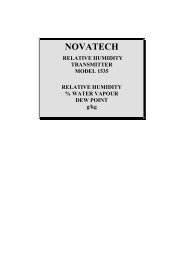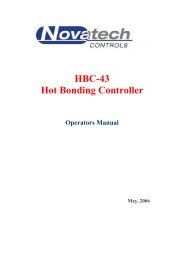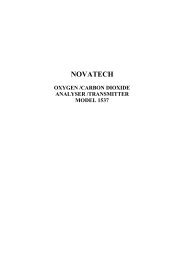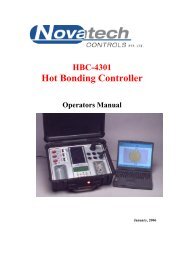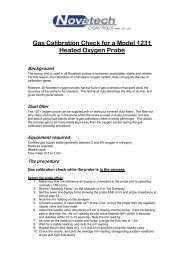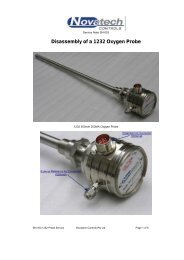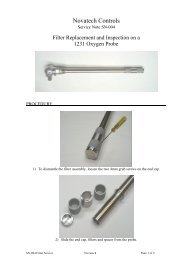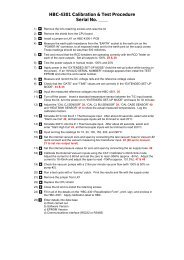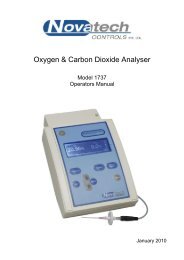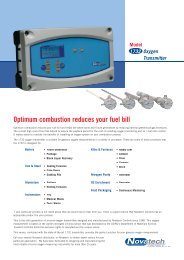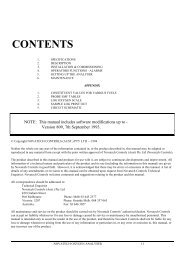1633 Combustion Controller Manual - Novatech Controls
1633 Combustion Controller Manual - Novatech Controls
1633 Combustion Controller Manual - Novatech Controls
You also want an ePaper? Increase the reach of your titles
YUMPU automatically turns print PDFs into web optimized ePapers that Google loves.
2.2 THE OXYGEN PROBEThe probe assembly provides a means of exposing the zirconia sensor to the atmosphere to be measured with sensor,thermocouple and heater wires connected via the analyser lead. Reference air is fed via the plug for unheated probesand via a separate gas thread connection for heated probes.Connections are provided on probes for an in-situ gas calibration check. A cleaning purge of air can be admitted viathe calibration gas check entry. The outer sheath of probes can be metal or ceramic, depending on the application.Calibration check can be achieved on 1234 sensors using a three way solenoid which blocks the sample and at the sametime admits a calibration check gas to the sensor. Purging a probe for any dust build up can be achieved in the sameway.In-situ zirconia oxygen probes will give a lower oxygen reading than a sampled gas measurement on a chromatographor paramagnetic analyser because the flue gas contains a significant level of water vapour and a sampling systemremoves the water vapour through condensation. The oxygen content then appears as a higher percentage of theremaining gas. For example: If the gas contained five parts oxygen and fifteen parts moisture, removing the moisturewould leave the oxygen at 5.88%. This phenomena will depend on the fuel and the completeness of combustion. Theyare common to all in-situ oxygen sensors.2.3 THE ANALYSERThe top line of the analyser display will read oxygen in either % or ppm.The <strong>1633</strong> analyser is a transmitter with two 4 to 20 mA outputs. One output is linear oxygen with selectable span. Thesecond output can be selected as oxygen deficiency, combustibles, auxiliary temperature, reducing oxygen, percentcarbon dioxide, sensor EMF or a logarithmic oxygen range. Four alarm relays are provided. Refer to the sections 4.2and 4.3 for more details.The <strong>1633</strong> analyser is designed to operate with one heated or unheated zirconia probe in a combustion process. Theanalyser will alarm when there is a high difference between the measured oxygen level and the required set pointoxygen. It can transmit and display the oxygen signal.In addition, a fixed oxygen set point, or a set point characterised to the burner firing rate can be used. The analyser willthen be able to control the air / fuel ratio to maintain the optimum burner efficiency and the safest operating conditions.The analyser has been designed to operate on boilers using dual fuels, and two independent characterisation tables canbe entered. The analyser will automatically go into a safe neutral control mode in the event of a probe failure.A MODBUS network connection in the analyser allows up to 31 analysers to be networked together back to a centralcomputer.If a heated probe is being used, the analyser will maintain the temperature of the sensor to over 700°C (1300°F). If theflue gas temperature is above 720°C (1330°F), the probe heater will cut out completely and the process will provideprobe heating. The analyser solves the Nernst equation and will provide accurate oxygen measurements up to 1500°C(2730°F), although most probes are suitable only to 1400°C (2250°F). 1231 heated probes are limited to 900°C(1650°F).2.4 ALARMSRefer to OPERATOR FUNCTIONS Section 4 for details on alarm functions.2.5 HEATERCAUTIONThe probe heater is supplied with mains voltage. This supply has electrical shock danger to maintenance personnel.Always isolate the analyser before working with the probe.The EARTH wire (green) from the probe / sensor must always be connected to earth.The heater is supplied from the mains power directly, and the temperature is controlled initially at over 700°C (1300°F)after turn on.2.6 APPLICATIONS WHERE SENSING POINT IS NOT AT ATMOSPHERICPRESSURETo apply the <strong>1633</strong> analyser to processes that have pressure at the point of measurement significantly above or belowatmospheric pressure, then compensation must be applied. (Refer to Set-up Steps 30 and 31 in Section 5.5August 2009<strong>1633</strong> <strong>Combustion</strong> <strong>Controller</strong> 15



